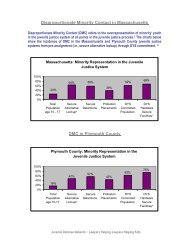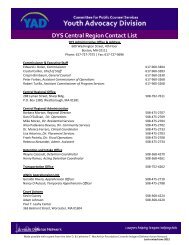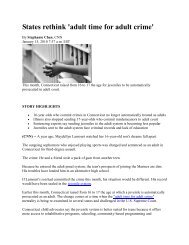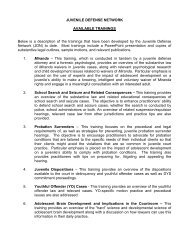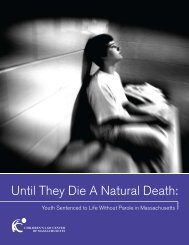Adolescent Brain Development - the Youth Advocacy Division
Adolescent Brain Development - the Youth Advocacy Division
Adolescent Brain Development - the Youth Advocacy Division
You also want an ePaper? Increase the reach of your titles
YUMPU automatically turns print PDFs into web optimized ePapers that Google loves.
Margo Gardner & Laurence Steinberg, Peer Influence on Risk Taking, Risk Preference, and Risky<br />
Decision-Making in Adolescence and Adulthood: An Experimental Study, 41 DEV. PSYCHOL. 625<br />
(2005).<br />
• Study finding that exposure to peers during a risk taking task doubled <strong>the</strong> amount of risky<br />
behavior among mid-adolescents (with a mean age of 14), increased it by 50 percent among<br />
college undergraduates (with a mean age of 19), and had no impact at all among young adults.<br />
• “[T]he presence of peers makes adolescents and youth, but not adults, more likely to take risks<br />
and more likely to make risky decisions.” (634)<br />
Press Release, National Institute on Alcohol Abuse and Alcoholism, <strong>Adolescent</strong> <strong>Brain</strong>s Show Reduced<br />
Reward Anticipation, (Feb. 25, 2004). http://www.nih.gov/news/pr/feb2004/niaaa-25.htm (last visited<br />
May 19, 2010)<br />
• Discusses how adolescents’ brains respond differently to incentives (risk/reward). Cites MRI<br />
study conducted on 12-17 year old and 22-28 year old subjects.<br />
• “<strong>Adolescent</strong>s show less activity than adults in brain regions that motivate behavior to obtain<br />
rewards, according to results from <strong>the</strong> first magnetic resonance imaging (MRI) study to examine<br />
real-time adolescent response to incentives.” (1)<br />
Laurence Steinberg & Elizabeth Scott, Less Guilty By Reason of Adolescence: <strong>Development</strong>al Immaturity,<br />
Diminished Responsibility, and <strong>the</strong> Juvenile Death Penalty, 58 AMER. PSYCHOL. 1009 (2003).<br />
• Explains from a medical standpoint how adolescent brain development affects culpability<br />
• “In general, adolescents use a risk-reward calculus that places relatively less weight on risk, in<br />
relation to reward, than that used by adults.” (1012)<br />
• “The vast majority of adolescents who engage in criminal or delinquent behavior desist from<br />
crime as <strong>the</strong>y mature.” (note 13, at 1015)<br />
IV. Reports and O<strong>the</strong>r <strong>Advocacy</strong> Resources<br />
CHILDREN’S LAW CTR. OF MASS., UNTIL THEY DIE A NATURAL DEATH: YOUTH<br />
SENTENCED TO LIFE WITHOUT PAROLE IN MASSACHUSETTS (2009).<br />
• Study examining <strong>the</strong> imposition of juvenile life without parole in Massachusetts. Includes<br />
discussion of MA law, adolescent brain and developmental research, statistics and vignettes about<br />
<strong>the</strong> youth sentenced to LWOP in MA, discussion of <strong>the</strong> experiences of youth in adult prisons,<br />
analysis of economic costs of <strong>the</strong> sentencing practice, and a summary of global sentencing<br />
practices with respect to juvenile life without parole.<br />
Wendy Paget Henderson, Life After Roper: Using <strong>Adolescent</strong> <strong>Brain</strong> <strong>Development</strong> in Court, 11 CHILD.<br />
RTS 1, 1 (2009).<br />
• <strong>Advocacy</strong> guide for using adolescent brain research in litigation prepared by A.B.A. Children’s<br />
Rights Litigation Committee. Issues addressed include competence, sentencing mitigation,<br />
duress and coercion, differences in assessing reasonableness and recklessness for juveniles, and<br />
mental responsibility.<br />
Connie de la Vega & Michelle Leighton, Sentencing Our Children to Die in Prison: Global Law and<br />
Practice, 42 U.S.F.L. REV. 983 (2008).<br />
• Examines international norms and practices regarding juvenile life without parole.<br />
• “The United States is <strong>the</strong> only violator of <strong>the</strong> international human rights standard prohibiting<br />
juvenile LWOP sentences. With thousands of juveniles serving LWOP sentences, and none<br />
serving such sentences in <strong>the</strong> rest of <strong>the</strong> world, <strong>the</strong> United States is <strong>the</strong> only country now violating<br />
this standard” (990)





